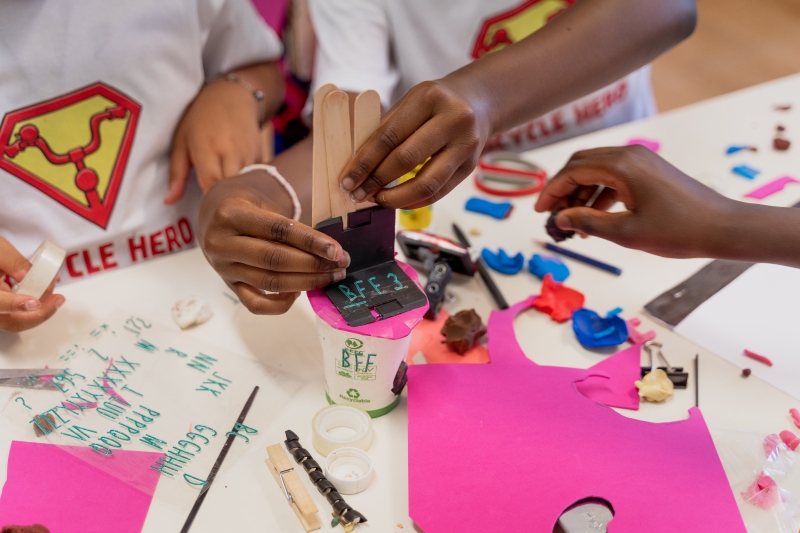Alex Baum, BYCS Programmes & Systems Manager, has been working throughout 2022, with support from EIT Urban Mobility and funding from the European Union, on an important expansion of our flagship children’s cycling stimulation programme Bicycle Heroes. As this year of pilots come to an end, he takes the opportunity in this article to explore the methodology and several successful impact measures of the initiative, as well as BYCS’ looking forward to building on these successes in 2023.
–
Programme Background:
BYCS mission has always centred on the needs and voices of demographics that face the largest barriers to cycling such as children, women, and caregivers. By not only prioritising these groups needs, but also voices, we aim to create cultures of inclusive decision making in cities, connecting civil society with decision makers. Bicycle Heroes is a programme that has these values embedded at its core.
Active in the Netherlands since 2018, this scale-up saw expansion to three new cities in partnership with key organisations – Dublin (with Dublin City Council and Trinity College), Lisbon (with Bicicultura and APSI), and Rome (with Roma Servizi per la Mobilità) – in order to gather learnings and refine the programme for further implementation.

Methodology
The Bicycles Heroes programme focuses on increasing the awareness and ownership of, and involvement in, mobility challenges and solutions, for children and families, key decision-makers, and the broader population, leading to an increase in investment in, and uptake of, cycling. To kick off projects in new cities, the first step for our implementing partners in Dublin, Lisbon, and Rome was engaging with key stakeholders. This included children and the general public with a goal of raising awareness about the need of, and increase the demand for, increased safety for, and use of, active mobility. The Bicycle Heroes approach also spotlights the importance of increased incorporation and amplification of the perspectives and ideas of children and general participation in active mobility projects. A number of events were conducted to bring together these groups to introduce the project in the first half of the year, to discuss the potential roles of the key stakeholders.
Children were introduced to the idea of active mobility and their participation in it via a series of presentations from key stakeholders and tours through their neighbourhood / school areas. The children then workshopped a number of potential ideas and the ones with the most potential were further designed and built out. In some cases, a competition was held to determine the best ones. The ideas were then presented to the public, either as part of an exhibition or at a local government meeting in order to raise awareness and secure further commitment to implement. Finally, a children’s council was formed in order to ensure that the work would continue – both in the sense of the implementation of the children’s ideas as well as the continued promotion of active mobility and amplification and incorporation of youth voice in active mobility projects.
Children’s Ideas
In each of the three cities, a number of interesting and innovative ideas were developed. In Dublin, in order for kids to develop bike repair skills, save on costly equipment, and increase intergenerational interaction, students developed the idea for neighbourhood repair hubs co-located at senior centres, where seniors could teach skills and repair bikes while interacting with young people to improve their wellbeing. In Lisbon, participants focused on the fact that many kids want to cycle to school but feel intimidated about the idea of riding alone. Similar to a Bicibus, this idea had kids riding together, chaperoned by parents, and making multiple ‘stops’ along a planned route where kids could join the ride. In Rome, the children pointed out how much longer pedestrians and cyclists have to wait to cross the street than cars, and thus have shorter time to cross, which is especially difficult for elderly people, parents, or people with disabilities. They proposed a more equitable timing of the traffic lights as well as a more demand-responsive system.

Impact
The programme is already having an immediate positive impact on the participating cities. In Lisbon, the Children’s Council established by Bicicultura has been given permanent space as a children’s group to act both as a consultative body for the organisation’s projects and activities, and as a youth group of its own right focused on the promotion of cycling culture, fluency and access for children. In Dublin, the City Council has agreed to employ more people in the school transport section, including senior engineers, which will be an important factor in implementing future Bicycle Heroes projects and continuing and expanding the Bicycle Heroes programme in Dublin. In Rome, local officials and teachers are interested in implementing the ideas of the children and continuing to expand the programme in partnership with Roma Servizi per la Mobilità.
The long-term impact of these activities includes highlighting a need for more investment and priority for cycling and greater consideration of the voices and needs of children. With the continued institutionalisation of Bicycle Heroes and the principles which they stand for in each of the cities, the call for this investment and prioritisation will grow and pressure will mount for change, leading to the realisation of the many benefits of a cycling city fit for all.
Further Expansion
Based on the learnings from the 3 pilots in 2022, BYCS plans to develop a market-ready version of the programme in the first half of 2023 that can be implemented by any city, organisation, or business interested in incorporating the ideas and perspectives of children into making their city safer, more prosperous, and more fun to cycle in for all.
You can learn more about the programme, and explore possibilities of commissioning it for your city here:

